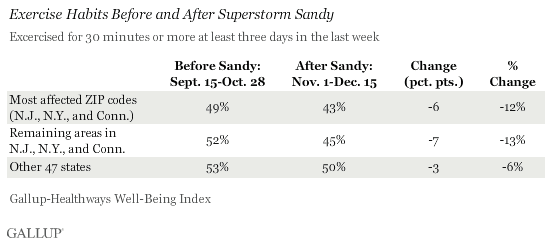WASHINGTON, D.C. -- Following Superstorm Sandy, residents of the most affected ZIP codes in New Jersey, New York, and Connecticut are less likely to report healthy behaviors than they were before the disaster.
Residents of the most affected ZIP codes are 12% less likely to report exercising for 30 minutes at least three days per week after the storm than before it. Those living elsewhere in New Jersey, New York, and Connecticut saw just as much of an impact on exercise, with a 13% decrease. While the Gallup-Healthways Well-Being Index typically finds that exercise decreases in the fall and winter, the decrease in these areas specifically is double the national average during the same time period.

Similarly, respondents in the most affected areas are 7% less likely to say they were eating healthy after the storm than before it -- more than double the decline in the rest of the affected states and significantly larger than the decline in the rest of the country.

Additionally, smoking appears to be up slightly in the most impacted ZIP codes -- rising from 14% to 17% -- while the smoking rate in the rest of America remains unchanged for that same period. These declines in healthy behaviors add to the apparent emotional impact Gallup found among the areas the storm hit hardest.
Implications
Gallup-Healthways Well-Being Index data collected after Superstorm Sandy demonstrate how a major disaster can measurably affect individual health choices. Both practical and emotional reasons may contribute to these results. First, due to major power outages and widespread property damage, these residents may not have had time to exercise or the ability to access or keep fresh food. Perhaps they had to resort to unhealthy eating in the six weeks following the storm.
Second, these data align with previous American Psychological Association research in stress management, which found that, in times of stress, Americans will engage in unhealthy behaviors such as poor diet choices, smoking, and inactivity. So, while a major storm and the fallout afterward will logically cause increased stress, the Gallup-Healthways Well-Being Index provides new data about the extent to which those changes can take place. In addition, all of the results mentioned above are statistically significant, and due to the magnitude of the storm, this translates to the healthy behaviors of hundreds of thousands of people.
Paradoxically, these types of unhealthy behaviors actually increase stress levels rather than reduce them, leading to a potential self-perpetuating downward spiral. While people might reach for "comfort food," "convenience food," or a cigarette during stressful situations, these quick fixes are likely to have a detrimental effect in the long run. By associating negative emotions with unhealthy choices, people might automatically default to these choices when future negative emotions arise. Instead, to break this type of spiral, experts recommend increased exercise.
Since the Gallup-Healthways Well-Being Index data only reflect adults over the age of 18, the impact of the storm on unhealthy behaviors may actually be greater when taking children into account. Previous research suggests that parental stress can be related to childhood obesity, so in jarring situations like a major storm, the impact may actually advance this growing health concern facing children.
While the scope of a major disaster can never be completely predicted, as people prepare for disasters and then deal with the aftermath, they should remember to maintain a healthy lifestyle as best they can to pre-empt or mitigate stress, especially through more regular exercise.
About the Gallup-Healthways Well-Being Index
The Gallup-Healthways Well-Being Index tracks well-being in the U.S. and provides best-in-class solutions for a healthier world. To learn more, please visit well-beingindex.com.
Survey Methods
Results are based on 6,414 interviews conducted from Sept. 15-Dec. 15, with adult residents of New Jersey, New York, and Connecticut. Gallup further broke out these interviews into two groups -- ZIP codes hardest hit by Sandy -- those receiving Individual Assistance from the Federal Emergency Management Administration -- and the remaining ZIP codes in those three states to analyze emotional health and healthy behaviors. For ZIP codes hardest hit, 1,713 interviews occurred before the storm (Sept. 15-Oct. 28) and another 1,690 after the storm (Oct. 31-Dec. 15), while 1,433 interviews happened before the storm and 1,578 after the storm within the remaining ZIP codes of the three states. During the same period, 35,184 interviews were completed before the storm and 36,081 after it among residents of the remaining 47 states.
For results based on the three sample types for either before or after the storm, one can say with 95% confidence that the typical margin of sampling error is ±2.1, ±2.4, and ±0.5 percentage points, respectively.
Interviews are conducted with respondents on landline telephones (for respondents with a landline telephone) and cellular phones (for respondents who are cellphone only).
In addition to sampling error, question wording and practical difficulties in conducting surveys can introduce error or bias into the findings of public opinion polls.
For more details on Gallup's polling methodology, visit https://www.gallup.com/.
